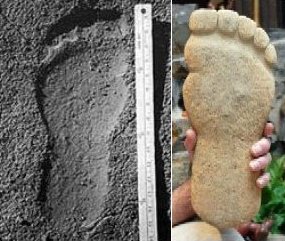
March 30, 2012
Over ten years ago, Ray Wallace died and his family members found fake wooden Bigfoot tracks in his garage. This lead to the discovery that some series of “Bigfoot” footprints in the Pacific Northwest had been planted by Ray Wallace or his agents – and were fakes.

In 2007, Mark Hall posted a review entitled “When Legends Meet Science” on his “Living Fossils” webpage about Jeff Meldrum’s then-new book, Sasquatch: Legend Meets Science. That page does not exist any longer, but one of the foundation themes contained within Hall’s critique is still worth pondering.
The databases of various Sasquatch researchers continue to contain examples of Ray Wallace’s fakery. Because of this, the collections throw off the summary statistics and general analyses of Bigfoot track information.
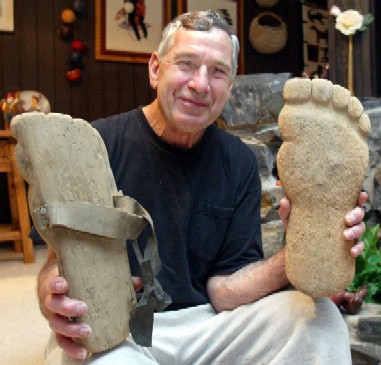
Dave Rubert photographs of the Ray Wallace fake Bigfoot footprint tools.
One section of Mark Hall’s review discussed the Ray Wallace wooden fake track creations, and how the imprints made from them are still appearing in works by some Sasquatch researchers.
Hall writes:
[Jeff] Meldrum fails to recognize that the Ray Wallace fake imprints have become part of his database. For a professional claiming an expertise in the study of footprints, this lapse is a costly and tragic error. He had a chance to rid himself of this pollution, but he has failed to do so.
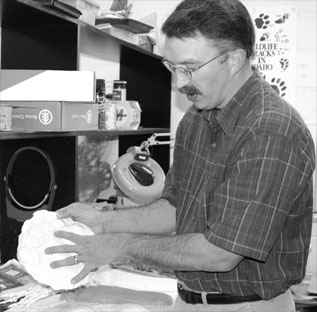
Meldrum did not have to uncover the fakery on his own. The history of how these fakes came into being has already been told. The hoaxing tools were publicly displayed in December of 2002 after Ray Wallace died. I was one who wanted to know how these fakes had found their way into so many places. They appeared in Sanderson’s 1961 book and in many popular books and articles since that time.
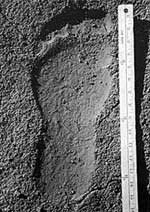
When it was shown that these were hoaxed impressions, it became important to throw out the trash and leave us with valid data. So I reviewed the records for the 1950s and 1960s. I published an article that came out in April of 2003 that illustrated the three sets of fake feet that were associated with Ray Wallace. I followed up with two more articles as more of the history of hoaxing emerged.* Meldrum has failed to learn the history and throw out the garbage.
Perhaps he has been unduly influenced by those who were also fooled by Ray Wallace and cannot acknowledge their mistakes. But Meldrum is not an amateur investigator. According to the publicity for this book he has even been given a grant of $30,000 to further his studies of the phenomenon. He should be leading the effort to throw out the bad data. Instead we find him defending the fakes.
In Legend Meets Science he illustrates only one of the most prominent of the wooden tools used, the right foot. It is the wooden tool for the left foot that produced the most often photographed images. It shows up in widely published cases of trackways seen in California. It has been cast in plaster, despite Meldrum’s assertion that it has not**. Those who cannot admit to this particular success by Ray Wallace have kept this tool out of the books they continue to publish, and Meldrum has taken the same sorry path by illustrating only one of the two wooden tools.
Keep these shortcomings in mind if you read this book.
^^^^^^^
* “The Real Bigfoot and Genuine Bigfoot Tracks” in Wonders, Volume 7, pages 99-125.
“The Bigfoot Community’s Wallace Problem” in Wonders, Volume 8, pages 44-53.
“October 1958 in the History of Bigfoot” in Wonders, Volume 9, pages 85-96.
– Mark A. Hall
**Further clarification/footnote from Hall: Meldrum does show a cast of the left tool on his page 68. But it is a lousy cast [thus allowing Meldrum to] say it doesn’t match. It was made by the tool and the cast shown beside it was a fake in the 13-inch size. But the medium at that location was good for imprints and not for making casts.

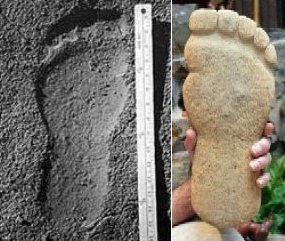
Don’t forget. To compare the wooden fake tool to the track in the ground, you must look at the mirror image of the footprint.
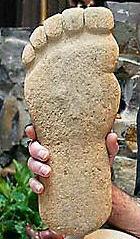
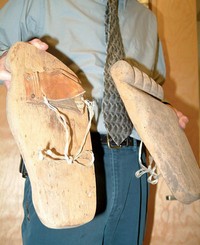
These wooden fakes are from the other members of the Wallace family, and show some of the earlier and/or rougher ones that Wallace employed.
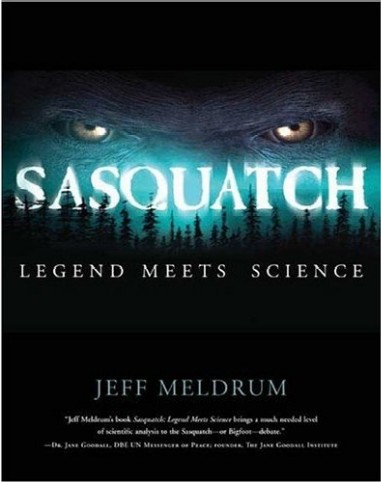
Sasquatch: Legend Meets Science by Jeff Meldrum.
About Loren Coleman
Loren Coleman is one of the world’s leading cryptozoologists, some say “the” leading living cryptozoologist. Certainly, he is acknowledged as the current living American researcher and writer who has most popularized cryptozoology in the late 20th and early 21st centuries.
Starting his fieldwork and investigations in 1960, after traveling and trekking extensively in pursuit of cryptozoological mysteries, Coleman began writing to share his experiences in 1969. An honorary member of Ivan T. Sanderson’s Society for the Investigation of the Unexplained in the 1970s, Coleman has been bestowed with similar honorary memberships of the North Idaho College Cryptozoology Club in 1983, and in subsequent years, that of the British Columbia Scientific Cryptozoology Club, CryptoSafari International, and other international organizations. He was also a Life Member and Benefactor of the International Society of Cryptozoology (now-defunct).
Loren Coleman’s daily blog, as a member of the Cryptomundo Team, served as an ongoing avenue of communication for the ever-growing body of cryptozoo news from 2005 through 2013. He returned as an infrequent contributor beginning Halloween week of 2015.
Coleman is the founder in 2003, and current director of the International Cryptozoology Museum in Portland, Maine.
Filed under Bigfoot, CryptoZoo News, Footprint Evidence, Forensic Science, Sasquatch